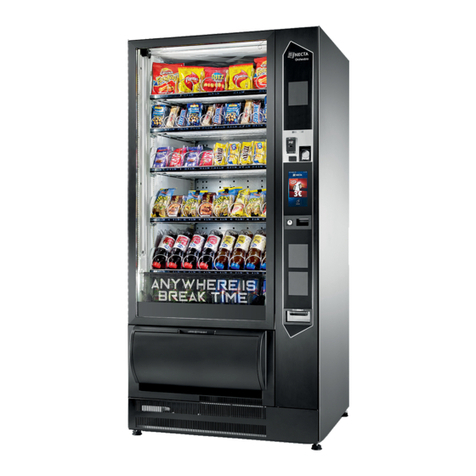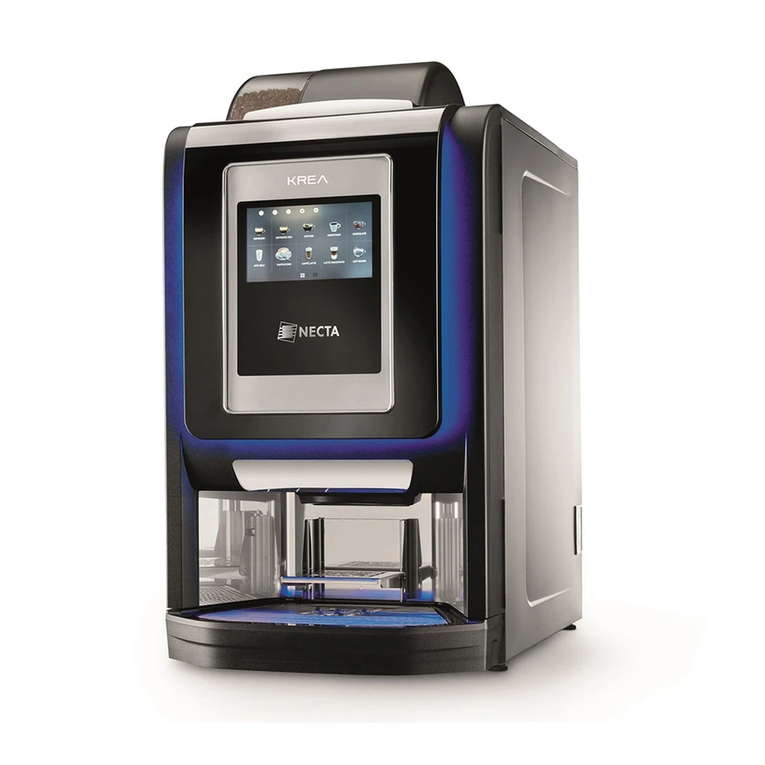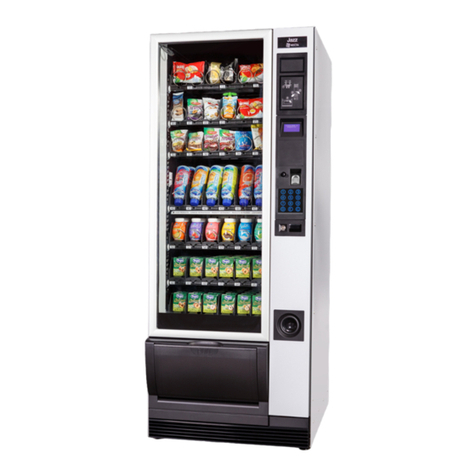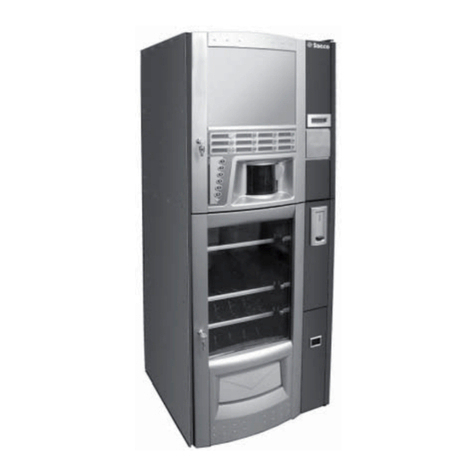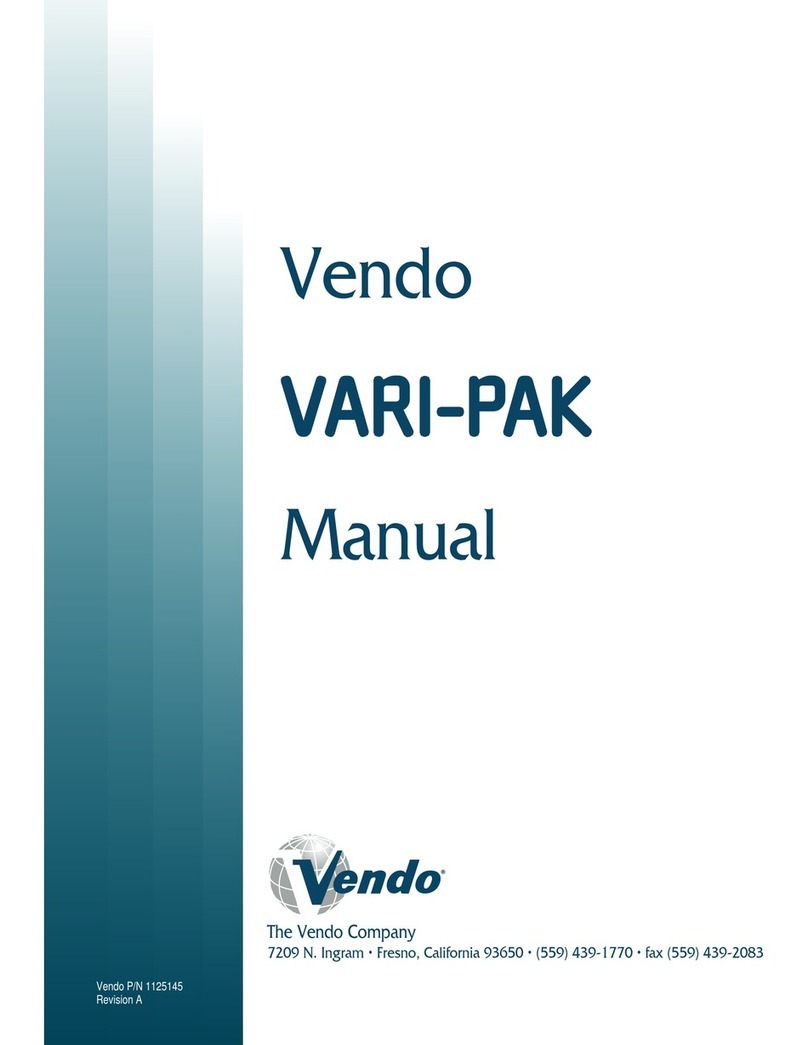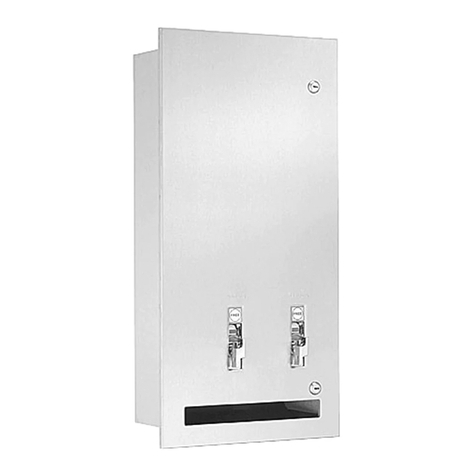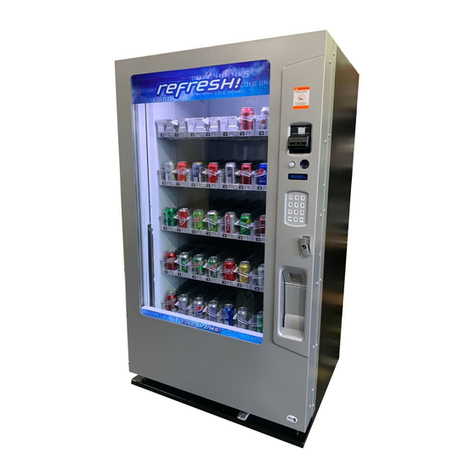EVOCA G150 Specification sheet

INSTALLATION, USE, MAINTENANCE
Translation of the original instructions
EN English
Doc. No. H0193EN01
Edition 2 07 - 2020
G150 120 / 240 V 60Hz UL NSF


Ed. 11 17
EVOCA S.p.A.
ad unico socio
Sede amministrativa e operativa: Via Roma 24
24030 Valbrembo (BG) Italia
Tel +39 035 606111
Fax +39 035 606463
www.evocagroup.com
Sede legale: Via Tommaso Grossi 2
20121 Milano (MI) Italia
Cap. Soc. € 41.138.297,00 i.v.
Reg. Impr. MI, Cod. Fisc. e P.IVA: 05035600963
Reg. Produttori A.E.E.: IT08020000001054
Cod. identicativo: IT 05035600963

integration of radio modules
In compliance with the national laws in
force, the manufacturer must check the
compliance of the radio equipment with
the essential requirements of the national
legislation.
The procedure used to check compliance
is at the manufacturer’s discretion.
If a radio module is built in a “non-radio”
equipment, the subject integrating the
module will become the manufacturer of
the end product and it must therefore check
the compliance of the end product with the
essential requirements of the national laws
in force in the country of installation of the
equipment.
As a matter of fact, the integration of radio
modules in other products can inuence
the compliance of the end product with the
essential requirements of the national laws
in force.
definitions according to the law
The manufacturer is a natural person who
or a public body which manufactures radio
equipment and/or electric material or has it
engineered, manufactured or marketed by
putting its own trademark or name on it.
An importer or distributor who places
radio equipment or electric material on the
market by putting its own name or trade-
mark becomes the manufacturer.
An importer or distributor who makes any
change to radio equipment or electric mate-
rial already placed on the market to such an
extent that the said change may condition
the compliance with the listed directives
is held to be the manufacturer and it must
therefore assume the relative obligations
according to the said directives.
Symbology
The following symbols may be present
inside the machines, according to models
(signs of danger)
Attention: dangerous voltage
Power o before removing the
cover
To reduce the risk of re or
electric shock, don’t remove
the cover. No user-servicea-
ble part inside.
Repairs should be done by
authorized service personel
only.
Attention
Danger of crushing your han-
ds
Attention
Hot surface
The signs of danger must be readable
and visible; they shall be neither hidden
nor removed. Damaged or unreadable
labels must be replaced.

Warnings
This document intended for the technical
personnel is made available in the electron-
ic format at the manufacturer’s (reserved
area web site).
for installation
The installation and any subsequent
maintenance operation shall be carried
out by the personnel skilled and trained
on the utilisation of the machine ac-
cording to the rules in force
The use of kits and/or accessories not
type-approved by the manufacturer can not
guarantee the observance of safety stand-
ards, in particular for live parts.
The installer will be the sole person respon-
sible for any damage improper installation
may cause to the machine or to things and
people.
The manufacturer declines all responsibility
for the use of non type-approved compo-
nents.
Assembly and any testing operation
must be carried out by qualied per-
sonnel who have a specic knowledge
of the machine operation from the point
of view of electric safety and health
rules.
The intactness of the machine and its
compliance with the standards of rel-
evant installations must be checked by
skilled personnel at least once a year.
Package materials must be disposed of in
observance of the environment.
For the vending machines of hot drinkts
only
The machine is equipped with an automatic
washing system for the mixers with the rela-
tive water circuit and the brewing unit.
If the machine is not used for some time
(weekends, etc.) even for pauses longer
than two days, it is recommended to enable
the automatic washing functions (e.g. be-
fore starting to use the VM.
for use
The machine can be used by children over
8 years and by people having reduced
physical, sensorial or mental skills under
the supervision of people responsible for
their safety or specically trained on the
use of the machine.
Children shall not be allowed to play with
the machine by the people in charge of
their supervision
Children shall not be allowed to clean or
service the machine.
for the environment
Some tricks will help you to protect the
environment:
-use biodegradable products to clean the
machine;
-properly dispose of all the packages of the
products used to fill and clean the ma-
chine;
-power off the machine during inactivity for
energy saving.
for dismantling and disposal
When dismantling the machine, it is rec-
ommended to destroy the machine rating
plate. The symbol shows that the ma-
chine can not be disposed of as
common waste, but it must be
disposed of as it is established by
the 2012/19/EU (Waste Electrical
and Electronic Equipment - WEEE)
European Directive and by the national
laws arising out of it in order to prevent any
negative consequence for environment and
human health.
The dierentiated collection of the machine
at the end of its life is organised and man-
aged by the manufacturer.
For the correct disposal of the machine
contact the sales point where you have
purchased the machine or our after-sales
service.
The unlawful disposal of the machine im-
plies the application of the administrative
sanctions provided for by the rules in force.
Attention!
If the machine is equipped with a cooling
system, the cooling unit contains HFC-
R134a uoridised greenhouse eect gas
ruled by the Kyoto protocol, the total heat-
ing potential of which is equal to 1300.


07-2020 0193 01 1
English
INTRODUCTION 2
transport and storagE 2
what to do should amalfunction occur 3
appliancE idEntification and fEaturEs 3
appliancE positioning 4
tEcHNical spEcificatioNs 4
powEr consumption 6
CLEANING AND LOADING 7
main switch and safEty mEasurEs 7
hygiEnE and clEaning 8
dispEnsing hot bEvEragEs into opEn containErs 9
coNtrols aND iNformatioN 9
loaDiNg proDucts 10
coffEE bEans 10
instant products 10
milk 11
intErnally suppliEd tank watEr 11
pErioDical opEratioNs 11
clEaning thE rEsiduE containErs 12
clEaning thE mixEr and diffusEr 13
clEaning thE nozzlEs and spouts 14
clEaning milk componEnts 14
clEaning thE brEwing unit 15
clEaning thE watEr supply tank 15
clEaning thE product containErs 15
switching thE machinE on 16
wasH cyclEs 16
mixEr wash cyclE 17
full appliancE wash cyclE 17
washing thE cappuccino makEr 17
brEwing unit wash cyclE 18
rinsing thE componEnts 19
clEaning thE touchscrEEn 20
sErvicE suspEnsion 20
INSTALLATION 21
unpacking thE appliancE 21
main switch and safEty mEasurEs 22
discarding thE solid and liquid rEsiduEs 23
rEmoving thE panEls 23
watEr supply 24
if thE appliancE usEs awatEr tank, appropriatE filtEr
cartridgEs can bE usEd. 24
ElEctrical connEction 25
wi-fi connEctions 26
iNitial start up 27
first sanitisation 27
opEratioN 28
variablE-dosE coffEE dosEr 30
dispEnsing milk 31
dElivEry of hot watEr from spout 31
stEam dElivEry from spout 31
calibration chEcks and sEttings 32
connEctivity 33
touchscrEEn 34
usE of usb mEmory stick 34
opEratioN iN Normal usEr status 34
dispEnsing abEvEragE 35
appliancE status 35
systEm architEcturE 36
PROGRAMMING 37
accEssing thE programming mEnus 37
EntEring valuEs 38
daily actions 39
sElEction sEttings 39
machinE sEttings 45
machinE information 51
EnErgy saving modE 55
paymEnt systEms 57
import/ Export 60
systEm 61
connEctivity 65
MAINTENANCE 66
gEnEral introduction 66
main switch and fusE 66
maintaining thE brEwing unit 67
pErioDical opEratioNs 69
sanitisation 69
clEaning thE nozzlEs and spouts 71
rEmoving thE product containErs 72
rEmoving thE sidE and rEar panEls 72
circuit boarD fuNctioNs 73
powEr supply 73
paymEnt form board 73
activation board 74
boilEr thErmal protEction 75
softwarE installation and/or updating 76
APPENDIX 77

207-2020 0193 01
Introduction
The technical documentation forms an
integral part of the appliance and must
therefore accompany any movement or
transfer of ownership in order to allow
the various operators to further consult
the documentation.
Before installing and using the appliance,
the document contents need to be scrupu-
lously read and understood, as the manual
provides important information regarding
installation safety, provisions of use and
maintenance work.
Some illustrations in this manual may show
details that are dierent from those of the
appliance, without however modifying the
essential information.
The manual is divided into three chap-
ters.
Chapter 1 describes the loading and rou-
tine cleaning operations to be performed
in the areas of the appliance which can be
accessed via a key-operated door, without
needing to use other tools.
Chapter 2 contains the instructions needed
for a correct installation and the information
required to optimise the appliance's perfor-
mance.
Chapter 3 describes the maintenance work
which requires the use of tools to access
potentially dangerous areas.
The operations described in chapter 2
and chapter 3 must solely be carried
-
edge of the appliance's operation both
from an electrical safety and hygiene
point of view.
TRANSPORT AND STORAGE
traNsportatioN
Special care must be taken when handling
the appliance in order to avoid causing
damage to the appliance and people.
When handling the appliance, there is a
Move the appliance using lifting equip-
ment that is suitable for the size and
-
ing equipment can use the equipment.
Avoid:
-Tipping over and/or tilting the appliance;
-Dragging or lifting the appliance with ropes
or similar;
-Lifting the appliance with lateral grips;
-Shaking or tossing the appliance and its
packaging.
storagE
The storage environment needs to be dry
and of a temperature between 32 and 104
° F.
If the appliance freezes, it must be condi-
tioned in environments with temperatures
between 32° and 104 °F.
Wait until the appliance's temperature
reaches the same temperature as its sur-
rounding environment before switching it
on.

07-2020 0193 01 3
WHAT TO DO SHOULD A
MALFUNCTION OCCUR
In most cases, technical problems can be
solved by means of small interventions; we
therefore suggest that this manual is read
carefully before contacting the manufac-
turer.
If the anomalies or malfunctions cannot be
solved, please contact:
Evoca S. p. A.
Via Roma 24
24030 Valbrembo
Italy - Tel No. +39 035606111
APPLIANCE IDENTIFICATION AND
FEATURES
Each appliance is identied by means of a
specic serial number which can be found
on the nameplate located on the internal
side of the door.
The nameplate is the only one recognised
by the manufacturer and contains all the
information that allows the manufacturer to
quickly and safely provide all kinds of tech-
nical information and easily manage the
spare parts
TYPE/TYPECODE/CODE MODEL/MODEL SERIAL NR/SERIAL NR
CALDAIA/BOILER SOLUBILI/SOLUBLE
PRESSIONE/PRESSURE Mpa
CAPACITAí/CAPACITY dm3
PRESSIONE ACQUA RETE/MAINS WATER PRESSURE
TENSIONE/VOLTAGE FREQUENZA/FREQUENCY
POTENZA/POWER CORRENTE/CURRENT
WPOTENZA/POWER
CAFFE/CAFE VAPORE/VAPOUR
XX
1
2
3
4
5
6
7
8
9
10
Fig. 1
1. Code
2. Type
3. Model
4. Supply voltage
5. Power
6. Boiler data
7. Serial number
8. Supply frequency
9. Supply voltage
10. Water mains properties

407-2020 0193 01
APPLIANCE POSITIONING
The appliance is not suitable for outdoor
installations. It must be installed in a dry
environment, with a temperature between
35,6 °F and 89,6 °F and cannot be installed
in environments where jets of water are
used for cleaning (e.g. large kitchens, etc.).
The appliance must be installed in
environments where it can be overseen
The appliance can be positioned close to
a wall but there must be a gap of at least
1,5748 inches between the wall and the ap-
pliance for ventilation purposes.
Under no circumstances should the ma-
chine be covered with cloths or similar.
The appliance must be placed on a level
surface.
Important!
In the event of unscheduled maintenance
work and/or repairs, the appliance must be
able to be accessed from all sides.
Therefore, make sure that the appliance
can be rotated so that the back and side
panels can be removed.
The appliance satisfy the requirements
NSF only when are used 3.93 inches
feet
TECHNICAL SPECIFICATIONS
DimENsioNs
-Height inches 30,82
-Width inches 14,48
-Depth inches 23,07
-Depth with door open inches 33,62
-Weight Lbs 97
with cappuccino maker Lbs 103,61
783
586
368
854
Fig. 2
ElEctrical coNNEctioN
-Voltage: 120/240 V∿
-Frequency 60 Hz
The electrical features are detailed on the
data tag located inside the appliance.
watEr supply
water distribution pressure between 17,40
e 123,28psig (1.2-8.5 bar)
The appliance software has been designed
to manage the water supply from an inter-
nal tank (optional).

07-2020 0193 01 5
boilEr
27,05 oz capacity with 2900 W heating ele-
ment.
lEvEl of NoisE
The weighted continuous equivalent sound
pressure level is less than 70 dB.
EsprEsso aDjustmENts
-Coffee grain size
-Coffee dose
-Water Dose
iNstaNt aDjustmENts
-Instant powder doses
-Water dose
milk aDjustmENts
For models with a cappuccino maker only.
-Amount of milk
-Milk flow rate
-Emulsion (on/off)
-Steam-heating milk (on/off)
tEmpEraturE aDjustmENt
Sets the temperature of boiler/s from the
menu.
ENablE sigNs
-Water present
-Pressurized hydraulic circuit
-Coffee present
-Brewing unit in position
-Heating unit(s) temperature reached
safEty mEasurEs
-Product containers present
-Residue containers present
-Closed door sensor
-Boiler safety thermostats with a manual
reset
-Main electric circuit protection device with
fuse
-Steam boiler safety valve (models with a
cappuccino maker only)
couNtDowN protEctioN DEvicE of tHE:
-Coffee unit gearmotor
-Grinder(s)
tHErmal protEctioN DEvicE of tHE:
-Coffee unit gearmotor
-Electromagnets
-Grinders
-Motor-doser
-Motor mixer
-Pump
-Milk pump (models with a cappuccino
maker only)
coNtaiNEr capacity
They can contain the approximate quanti-
ties of the following products:
-Approximately 2,42 Lbs of coffee beans
-Approximately 2,42 Lbs of pre-ground
coffee
-Approximately 3,96 Lbs of instant choco6-
late
-Approximately 3,96 Lbs of instant ginseng
-Approximately 1,10 Lbs of instant barley
-Approximately 1,54 Lbs of instant milk

607-2020 0193 01
POWER CONSUMPTION
The power consumption of the appliance
depends on many factors, such as the tem-
perature and ventilation of the environment
where the machine is located, the tempera-
ture of the inlet water, the temperature in
the boiler, etc.
The calculated power consumption is indic-
ative only.
A measurement at a room temperature of
71,6 °F was carried out and the following
power consumption was detected:
ESPRESSO
Temperature reached Wh -
24-hour standby Wh -
ESPRESSO + STEAM
Temperature reached Wh -
24-hour standby Wh -
accEssoriEs aND kit
The appliance can be tted with acces-
sories and kits in order to vary its perfor-
mances:
The accessories and kits which can be at-
tached to the appliance are available from
the manufacturer.
The accessories and kits are supplied with
installation and test instructions, which
should be scrupulously followed in order to
maintain the safety of the appliance.
The party that performed the installation is
responsible for any damage that may occur
to the appliance, or to things and people
due to incorrect installation.
Important!
Accessories and kits which have not been
approved by the manufacturer, may not
comply with the safety standards, most
especially in regards to live parts.
The manufacturer declines any responsibil-
ity if non-approved components are used.
The installation and subsequent test
operations must be performed by quali-
of the appliance's operation both from
an electrical safety and hygiene point of
view.

07-2020 0193 01 7
Chapter 1
Cleaning and loading
The appliance is not suitable for outdoor
installations. It must be installed in a dry
environment, with a temperature between
35,6 °F and 89,6 °F and cannot be installed
in environments where jets of water are
used for cleaning (e.g. large kitchens, etc.).
MAIN SWITCH AND SAFETY
MEASURES
maiN switcH
The (manual) main switch cuts o the
power to the appliance and is positioned
behind the solid residue container.
When carrying out normal cleaning and
product loading tasks, the appliance does
not have to be switched o.
If the appliance needs to be switched o
via the main switch, the residue container
must be removed.
safEty mEasurEs
The routine cleaning and product loading
tasks can be performed safely.
The unit has magnetic sensors which de-
tect:
-The closing of the door
-The presence of the containers
-The presence of the residue containers
In the absence of one of the listed condi-
tions, the appliance is disabled.
1
Fig. 3
1. Main switch

807-2020 0193 01
HYGIENE AND CLEANING
points and includes information about
controlling the possible growth of bac-
teria.
Under the current health and safety
regulations, the operator of the appli-
ance must apply the self-control pro-
the HACCP (Hazard Analysis Critical
legislation.
It is also a good idea to sanitise the surfaces
which do not come into direct contact with
the food inside the appliance, as well as the
side modules (cup warmers, coolers, etc.).
The sanitisation must be performed using
disinfectants, taking care to mechanically
remove the residues and visible lms using
swabs and/or brushes.
Do not use solvents and/or strong-scented
detergents.
Some parts of the appliance can be dam-
aged by aggressive detergents.
The manufacturer shall not be held respon-
sible for any damage caused due to the
non-observance of the above or the use of
aggressive or toxic chemical products.
Do not under any circumstances use
water jets to clean the appliance.
9
1
2
3
4
5
6
7
8
10
12
11
Fig. 4
1. Hot water spout*
2. Nozzle-moving handle
3. Brewing unit
4. Decaffeinated coffee chute*
5. Door lock
6. Door for decaf
7. Container lock*
8. Container cover
9. Product container
10. Mixer*
11. Milk hose**
12. Steam nozzle**
* Only some models.
** Only models with a cappuccino maker.

07-2020 0193 01 9
DISPENSING HOT BEVERAGES
INTO OPEN CONTAINERS
The machines that dispense beverages into
open containers must be used exclusively
for the sale and distribution of drinks which
are produced via:
-Coffee infusion
-The reconstitution of instant or freeze-
dried products.
These products must be declared by the
manufacturer as “suitable for automatically
dispensing” into open containers.
Models with cappuccino makers can also
be used to dispense pasteurised or UHT
milk which has been kept refrigerated and
drawn from an external tank.
-
ance with the manufacturer instructions
regarding storage, storage temperature
and expiry date.
-
sumed immediately and must, under no
-
aged for later consumption.
Any other use is considered improper
and therefore potentially dangerous.
CONTROLS AND INFORMATION
The appliance must operate at a room tem-
perature between 35,6 °F and 89,6 °F
The controls and information for the user
are on the external side.
All messages destined for the user are
shown on the appliance's display.
6
2
3
1
5
4
7
8
Fig. 5
1. Liquid residue container
2. Dispensing nozzles
3. Nozzle-moving handle
4. Hot water dispensing nozzle*
5. Steam dispensing spout**
6. Touch screen
7. Decaffeinated coffee door*
8. Product containers (2 or 3 depending on the
model)
* Only some models.
** Only models with a cappuccino maker.

10 07-2020 0193 01
LOADING PRODUCTS
they have been stored in compliance
with the manufacturer instructions re-
garding storage and the storage tem-
perature.
expiration date.
The products must be declared by the
manufacturer as suitable for automatically
dispensing into open containers.
Products may also be loaded with partially-
full containers.
COFFEE BEANS
It is recommended to use high-quality cof-
fee beans in order to avoid appliance failure
due to the presence of impurities.
1. Open the container lid using the key
(if present).
2. Fill the container with coffee beans.
3. Carefully close the lid.
Do not exceed the maximum capacity
of the containers; the maximum level of
the containers coincides with the sup-
port point of the lid.
INSTANT PRODUCTS
It is recommended to use high-quality
instant products in order to avoid appliance
failure due to the presence of impurities.
1. Open the instant powder container lid us-
ing the key (if present).
2. Fill the container with instant powder.
3. Carefully close the lid.
Avoid compressing the powder in order
not contain any clumps.
Do not exceed the maximum capacity
of the containers; the maximum level of
the containers coincides with the sup-
port point of the lid.
1
2
MAX
Fig. 6
1. Container
2. Container lock*
*Certain models only

07-2020 0193 01 11
MILK
For models with a cappuccino maker only.
The milk is drawn via a pipe from the milk
container.
Only use pasteurised or UHT (Ultra
With regards to preserving milk, carefully
follow the manufacturer's holding tempera-
ture instructions and check the product's
expiry date.
the appliance.
The suction hose must rest on the bottom
of the milk container and not be looped.
-
ance with the food safety and hygiene
requirements.
Do not exceed the milk tank's maximum
capacity; the maximum level is indicated on
the tank with a reference mark.
INTERNALLY SUPPLIED TANK
WATER
For models with an internally supplied wa-
ter tank only.
Every day, when the machine is rst turned
on, the tank must be emptied of any resid-
ual water and sanitised when the no water
warning appears, whilst making sure to me-
chanically remove any residues and visible
lms using swabs or brushes, if necessary.
To restore service:
1. Fill the tank with clean drinking water
which is clear and free from impurities.
2. Connect the tank to the appliance.
3. Confirm the reset operation.
-
pacity; the maximum level is indicated
PERIODICAL OPERATIONS
points and includes information about
controlling the possible growth of bac-
teria.
Under the current health and safety
regulations, the operator of the appli-
ance must apply the self-control proce-
HACCP (Hazard Analysis Critical Con-
For each product load or more frequently,
depending on how often the appliance is
used, the incoming water quality and the
products used, it is necessary to clean and
sanitise the appliance and parts that come
into contact with the food, by proceeding as
described in the following paragraphs.
Apart from the external parts of the brewing
units and mixers which need to be cleaned
so that any powder residue is removed,
especially in the funnel area, the parts of
the mixer which come into contact with the
beverage should also be sterilised.
Do not under any circumstances use
jets of water directly on the appliance
when cleaning.

12 07-2020 0193 01
CLEANING THE RESIDUE
CONTAINERS
The residue containers can be easily re-
moved to make emptying and cleaning
easier.
The residue containers must be cleaned
with the machine switched on and the door
closed.
liquiD rEsiDuEs
The liquid residue container can be easily
removed, even if it is directly connected to
a drain in the mains.
Pull on the liquid residue container to re-
move it.
If the liquid residue container is not directly
connected to a drain in the mains, it will
need to be emptied on a regular basis.
Proceed to sanitise the container.
soliD rEsiDuEs
moDEls witH asoliD rEsiDuE coNtaiNEr
The appliance control software noties
when the maximum number of dispenses
has been reached.
The selections which involve coee are
disabled.
To remove the solid residue container, the
dispensing nozzles must be lifted up using
the movement lever.
1. Empty and wash the containers with a
sanitising solution.
2. Reset the solid residue counters to zero
(solid residue container empty function).
2
1
3
Fig. 7
1. Nozzle-moving handle
2. Solid residue container
3. Liquid residue container
moDEls witH soliD rEsiDuE DiscHargE oN tHE
bENcH
Proceed as follows:
1. Lift the dispensing nozzles using the
movement lever.
2. Remove the liquid residue container.
3. Remove the solid residue chute cover.
4. Empty and clean the solid residue con-
tainer.
5. Wash the solid residue chute to remove
any coffee residue.
6. Reinsert the residue chute and the resi-
due container.
1
2
3
Fig. 8
1. Nozzle-moving handle
2. Solid residue chute
3. Solid residue chute cover

07-2020 0193 01 13
CLEANING THE MIXER AND
DIFFUSER
After each load and/or on a weekly or more
frequent basis, depending on how often the
appliance is used, the quality of the incom-
ing water and the products used, the mixers
must be sanitised.
The parts that need to be cleaned are: The
powder deposit trays, instant drink dispens-
ing mixers and pipes and the diffuser.
5
4
6
3
2
1
7
Fig. 9
1. Instant powder funnel
2. Instant powder tray
3. Water funnel
4. Mixer fan
5. Instant beverage hose connection
6. Mixer locking ring
7. Brushes for cleaning hoses and “ splash zone “
To clean the mixer, proceed as follows:
1. Disconnect the instant beverage hose
from the connection of the water funnel.
2. Turn the water funnel locking ring anti-
clockwise and remove the mixer from the
appliance.
3. Separate all the components (the instant
products funnels, the water funnels, the
conveyors, the powder trays).
4. Remove the fans: block the disk fitted
on the motor mixer shaft with one finger,
then unscrew the mixer fan.
Fig. 10
5. Soak the components for about 20 min-
utes in a container filled with a hot water,
whilst taking care to mechanically re-
move the residues and visible films using
swabs for hose and brushes for mixers.
6. Rinse thoroughly each part carefully.
7. Reassemble the fans.
8. Reassemble the mixer parts and cor-
rectly reposition the water funnel.
Check that it has been correctly inserted.
Fig. 11
9. Turn the water funnel locking ring clock-
wise in order to secure the mixer to the
appliance.

14 07-2020 0193 01
After installing the components, it is
-perform mixer wash from the programming
menu
-Then thoroughly rinse the components
in order to remove any sterilising solution
residue.
CLEANING THE NOZZLES AND
SPOUTS
Weekly or more frequently, depending on
how often the appliance is used and the
quality of incoming water, it is necessary
to sanitise the instant beverage dispensing
ducts and nozzles.
To clean the nozzles, proceed as follows:
1. Pull down the nozzle-moving handle.
2. Remove the cover and disconnect the
hoses from the nozzles.
3. Disconnect the coffee dispensing hose
from the flow divider nozzle.
4. Unhook the flow divider nozzle from the
nozzle support.
5. Remove the flow divider, milker nozzle (if
present) and the instant beverage nozzles.
6. For models with a cappuccino maker,
separate all the parts of the milker nozzle.
7. Proceed to sanitise all the components,
taking care to mechanically remove
residues and visible films using swabs or
brushes, if necessary.
8. Clean the spouts (if present) with a clean
cloth and hot water
2
1
Fig. 12
1. hot water spouts
2. steam spouts
moDEls witH acappucciNo makEr
1 3
4
2
Fig. 13
1. Nozzle-moving handle
2. Milker nozzle
3. Instant beverage nozzles
4. Movable nozzle cover
5. Flow divider nozzle
CLEANING MILK COMPONENTS
Only models with cappuccinatore.
milk NozzlE
14
2
3
5
Fig. 14
1. Nozzle-moving handle
2. Movable nozzle cover
3. Coffee nozzle
4. Instant beverage nozzles
Table of contents
Other EVOCA Vending Machine manuals
Popular Vending Machine manuals by other brands

SandenVendo
SandenVendo Snack Safety Point SVE SSP Programming manual

Fastcorp
Fastcorp EVOLUTION FS-01 Setup and user guide
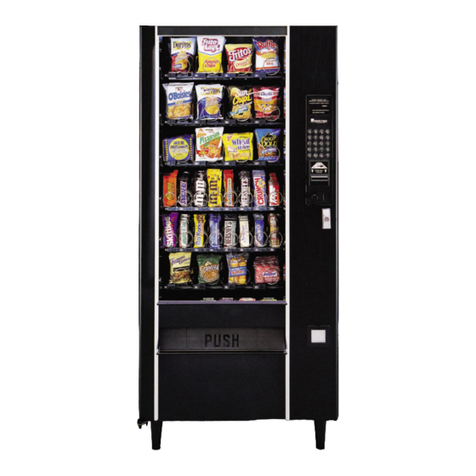
Automatic Products
Automatic Products SNACKSHOP LCM1 Series instruction manual
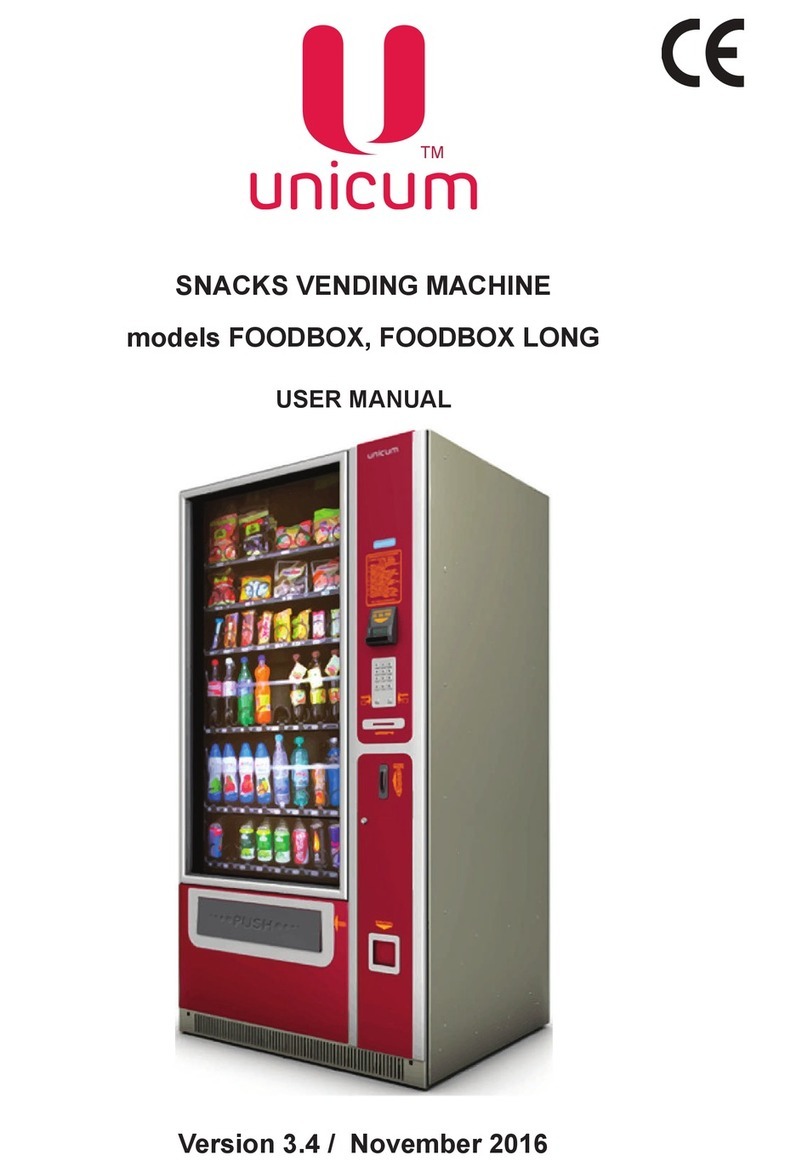
Unicum
Unicum Foodbox user manual
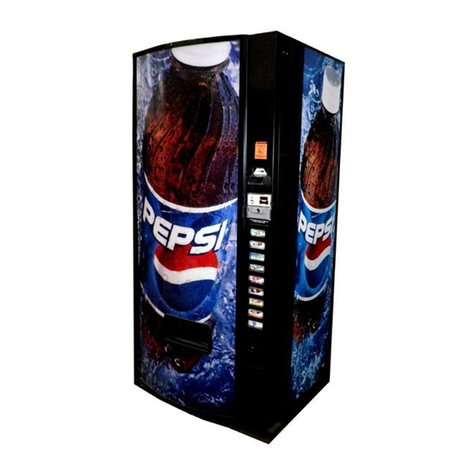
Dixie Narco
Dixie Narco 90 Series Operation manual
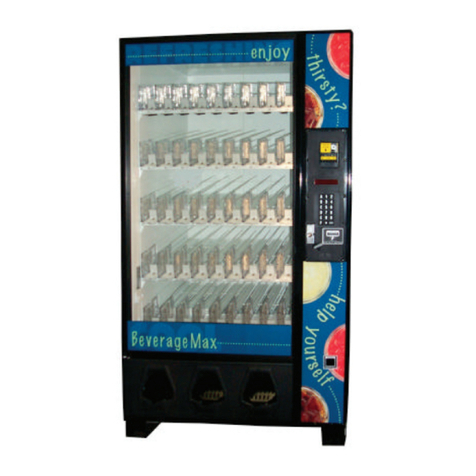
Dixie Narco
Dixie Narco DN 55 Series Technical manual
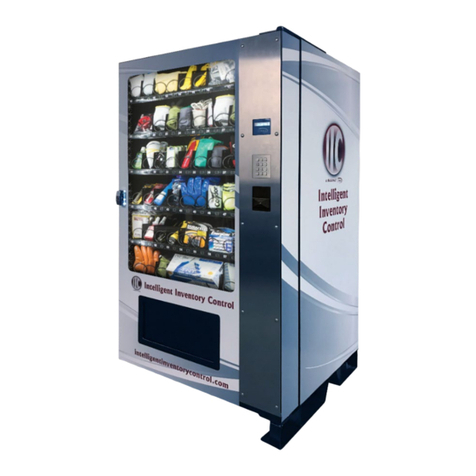
Seaga
Seaga Intelligent Inventory Control IQ640 Service and parts manual
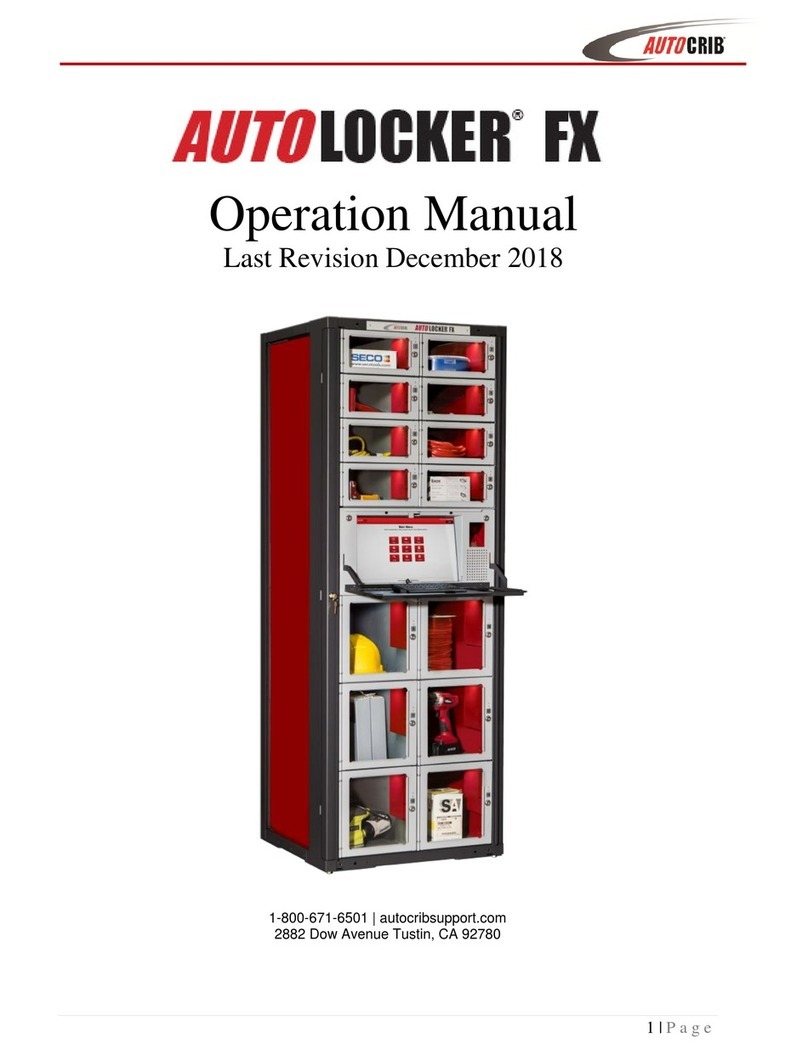
AutoCrib
AutoCrib AUTOLOCKER FX Operation manual
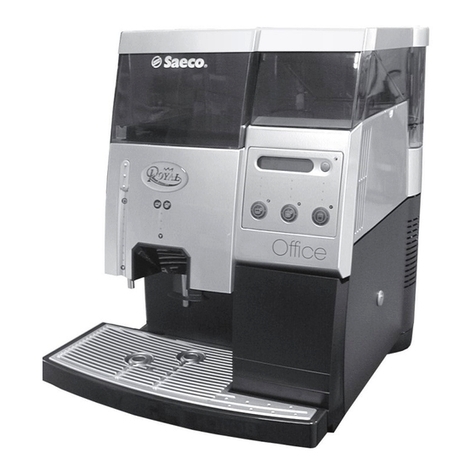
Saeco
Saeco ROYAL OFFICE SUP 015V Operation and maintenance

Wittenborg
Wittenborg Necta BRIO 250 Service manual
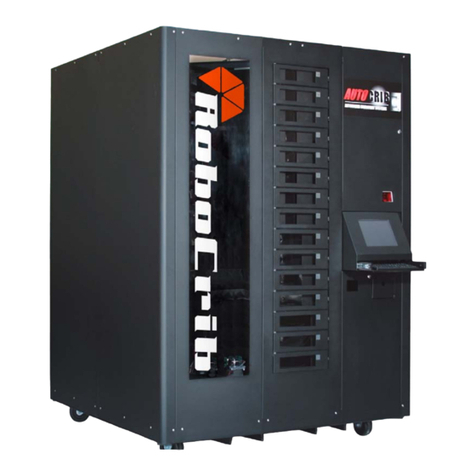
AutoCrib
AutoCrib C Operation manual
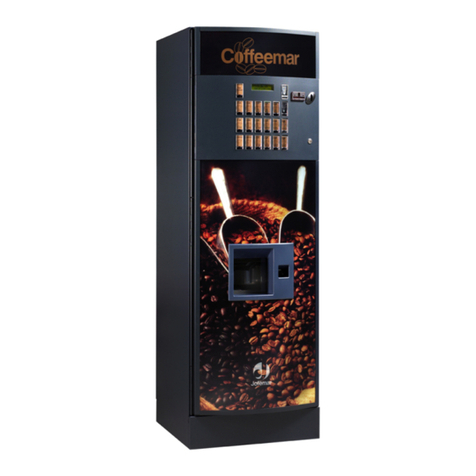
Jofemar
Jofemar COFFEEMAR G-500 V2 user manual
